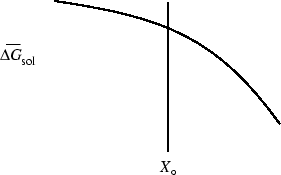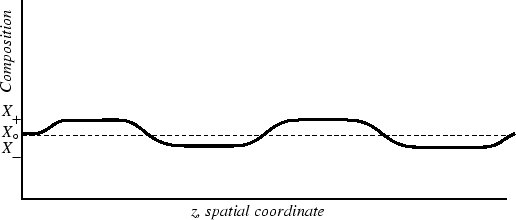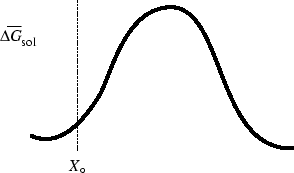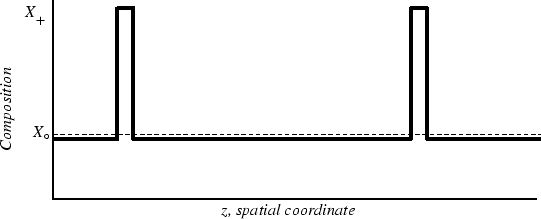 |
For those cases in which the molar free energy of mixing has regions of negative curvature (as in the example of the regular solution model), the mechanism by which the system decomposes into its equilibrium phases is different than the mechanism when the curvature is positive. This distinction between mechanisms when the curvature is negative (called the spinodal decomposition mechanism) when the curvature is positive (called the nucleation and growth mechanism) is important for kinetics. It will be useful to discuss the spinodal mechanism in the context of free energy curves.
Consider a part of the free energy curve where the curvature is negative:
Suppose that a material is manufactured with a composition
![]() that
is a function of some spatial coordinate
that
is a function of some spatial coordinate
![]() :
:
 |
Suppose that a very small fluctuation occurs and consider what happens to the free energy for the small fluctuation:
Apparently, the free-energy charge is negative for an arbitrarily small fluctuation in composition such that one part of the system gets more concentrated at the expense of another. The system is inherently unstable and and phase separation will proceed as illustrated:
This process is called spinodal decomposition and it occurs spontaneously when
 |
(32-17) |
Consider the part of the curve where the curvature is positive but inside the miscibility gap (miscibility gap is another way of saying the two-phase region):
Apparently, the free energy increases. Therefore, the system is ``stable'' with respect to small fluctuations. In other words, it is metastable with respect to infinitesimal composition fluctuations.
Such a system is clearly unstable to the separation into the limiting compositions given by the common tangent construction. How does the system phase separate?
 |
Apparently an average composition within the two phase region, but outside of the spinodal curves requires large composition fluctuations to decrease the energy. Therefore, the system phase separates as illustrated in the following cartoon:
 |
A process requiring a large composition fluctuation is called ``nucleation.'' After the nucleus forms, the new phase grows. Together, the process is called nucleation and growth.
This kinetic information can be graphically codified into the phase diagram: